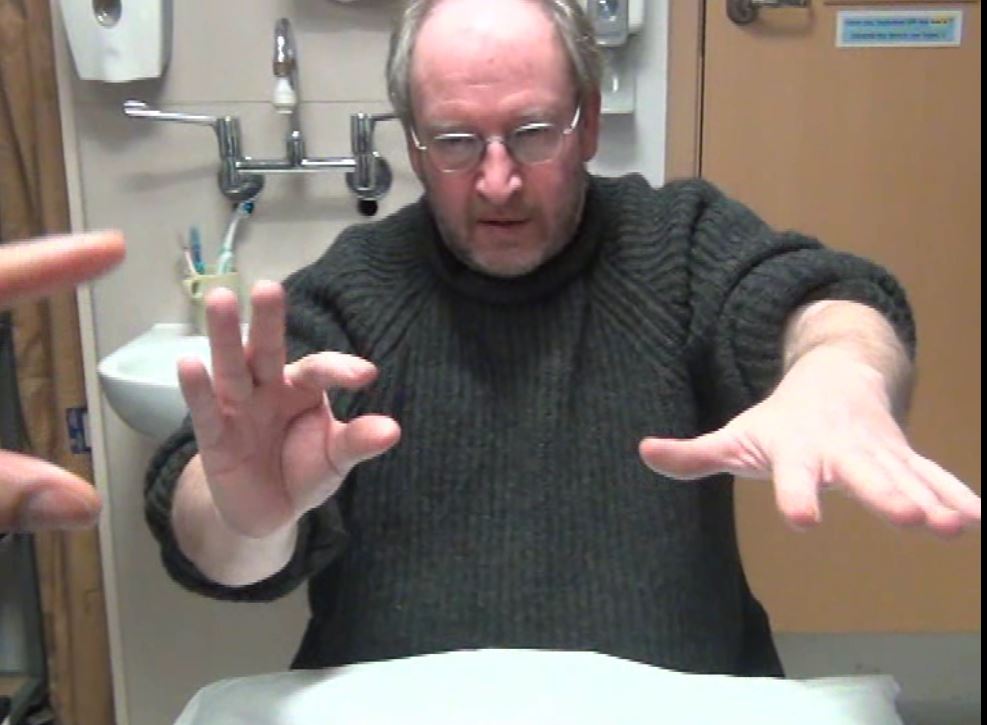Functional tremor is the commonest type of functional movement disorder.
In functional tremor there is uncontrollable shaking of a part of the body, usually an arm or a leg. This is due to the nervous system not working properly but not due to an underlying neurological disease.
Functional tremor is sometimes mistaken for Parkinsons disease or other causes of tremor such as ‘Essential tremor’
Unlike Parkinsons disease, functional tremor is due to a reversible problem in the way that the nervous system is working.
This means that a functional tremor can improve and sometimes go away completely although there is no “magic treatment”.

A tremor is a rhythmical movement of an arm, leg or other body part such as the head. Functional tremor may come and go through the day. The tremor may become violent at times and change in speed.
Having a functional tremor can be disabling as the movements cannot be controlled (ie they are involuntary)
Functional tremor often begins quite suddenly but may be gradual. It may follow on from one of the following situations
The diagnosis of functional tremor is usually made by a neurologist. It can be a particularly difficult diagnosis to make because it requires expert knowledge of the full range of tremors due to neurological disease, many of which are unusual .
The following are some examples of things a neurologist would look for to diagnose functional tremor
Its quite common for people with FND, and other functional disorders, as well as other neurological conditions, to experience a type of tremor that they can feel inside but which other people can’t see. This is sometimes called ‘internal tremor’. Sometimes there is a very slight tremor which people have trouble seeing.
Internal tremor can really trouble some people, and it may be of some help to know that other people have it. In the context of FND its mechanism, like many others, probably relates to an increase in a ‘volume knob’ of how the brain perceives movement and internal bodily sensations.
In fact its normal to have a very slight tremor if you hold your hands out in front of you. This is called physiological tremor. Internal tremor in some people arises because their brains become aware of that process and then it becomes ‘amplified’ over time
Have a look through the pages on treatment on this website
It is essential that you feel that you have the correct diagnosis. If you dont it will be hard to put into practice the rehabilitation techniques suggested here.
If you dont feel that you have functional tremor you need to look at what basis the diagnosis has been made. You should have some of the clinical features described above. If you do, why dont you have confidence in the diagnosis you have been given?
You do not need to be stressed to have functional tremor. In fact functional tremor is often most noticeable when peope are relaxed or not thinking about anything in particular. Perhaps you rejected the diagnosis because the doctor suggested it was “stress related”? – there may have been a misunderstanding if that was the case. We know that many patients with functional tremor do have stress as a cause of their symptoms, but many dont. So whether you have been stressed or not is not relevant to the diagnosis.
(With thanks to Glenn Nielsen, Physiotherapist at Institute of Neurology, London)
All of these need to be practised repeatedly, and many will seem impossible or difficult to begin with. You are trying to break a ‘habit’ in your brain, that is not easy to do.
Have a look at the videos of doctors doing entrainment tests to get some ideas about this.
Video 1 + Video 2

Roper et al. How to use the entrainment test in the diagnosis of functional tremor. Pract Neurol 2013;13:396-398
Look on the treatment pages to find out more about specific treatments that may be relevant to you. Functional tremor, can in some patients, be especially linked to anxiety.
Commonly feelings of anxiety link to the tremor itself, what will people think about me? Am I going to start shaking all over? Will that be embarrassing? But these are still feelings of anxiety
Many patients with functional tremor don’t have anxiety, but if you do, it may be important to face up to that and seek specific treatment directed at controlling excessive worry. This can sometimes help.
Some patients report that episodes of tremor appear to ‘get rid’ of a build up of hard to describe, tense, dizzy symptoms. They dont want the tremor to happen, but recognise that when it does (if it happens as ‘episodes’) that it does seem to lessen those feelings. If this applies to you then it may be useufl to discuss that with your treating health professional.
Sometimes under hypnosis, tremor may improve and you may be able to learn self hypnosis to practice at home.


We will be re-directing you to the University of Edinburgh’s donate page, which enable donations in a secure manner on our behalf. We use donations for keeping the site running and further FND research.
